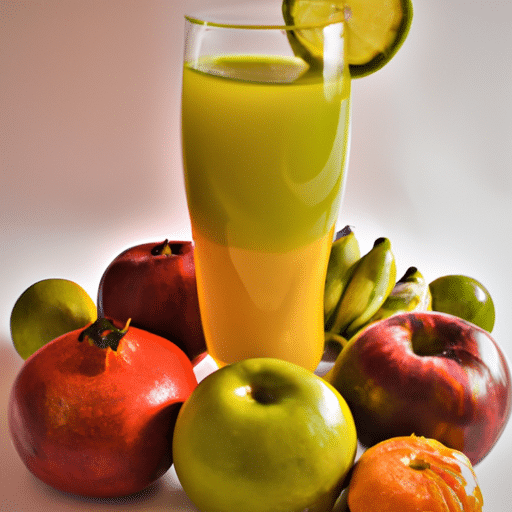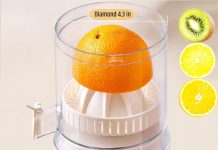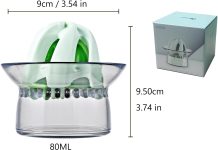Imagine this scenario: It’s a busy morning and you’re rushing to get ready for the day. As you grab a bottle of juice from the fridge, a thought crosses your mind – is drinking this juice an adequate substitute for eating whole fruits? In our article, we explore the question: Is it okay to drink juice instead of fruit? We dive into the nutritional benefits, potential drawbacks, and provide practical tips on how to make the most out of your juice consumption. So let’s get juicing and find out if swapping the real deal for a glass of juice is a worthy alternative!
Review contents
Benefits of Drinking Juice
1. Nutrient Intake
Drinking juice can be a convenient way to increase our nutrient intake. Juices are often packed with essential vitamins and minerals that are beneficial for our overall health. For instance, orange juice is a great source of vitamin C, which plays a crucial role in supporting our immune system and promoting healthy skin. Similarly, grapefruit juice is rich in antioxidants and vitamin A, which are important for maintaining good eye health. By incorporating different types of juices into our diet, we can ensure that we are getting a wide range of nutrients.
2. Hydration
One of the main benefits of drinking juice is that it helps us stay hydrated. Our bodies require an adequate amount of fluids to function properly, and consuming juices can be a delicious way to meet our hydration needs. In fact, many fruits used to make juice have high water content, such as watermelon and citrus fruits. By drinking juice, we can quench our thirst and replenish our body’s fluid levels, keeping us refreshed and energized throughout the day.
3. Convenience and Portability
When it comes to convenience and portability, juice takes the lead. Unlike whole fruits, which may require peeling, slicing, or even washing, juice can be easily consumed on-the-go. Whether we’re rushing to work or heading to the gym, a bottle of juice can be a handy option to grab and take with us. Additionally, store-bought juices often come in resealable containers, allowing us to enjoy them throughout the day without worrying about spoilage. With their convenience and portability, juices can fit seamlessly into our busy lifestyles.
Drawbacks of Drinking Juice
1. High Sugar Content
One of the main drawbacks of drinking juice is its high sugar content. While natural sugars found in fruits are not necessarily harmful, consuming excessive amounts of fruit juice can lead to a spike in blood sugar levels. This can be particularly concerning for individuals who have diabetes or are at risk of developing the condition. It is important to be mindful of the sugar content in the juices we consume and consider opting for lower-sugar varieties or diluting them with water.
2. Lack of Fiber
Juices, especially those that are processed or strained, often lack the dietary fiber that whole fruits offer. Fiber is an essential nutrient that aids in digestion, promotes satiety, and helps regulate blood sugar levels. When we consume whole fruits, we benefit from the natural fiber content present in their skins and pulp. However, when fruits are juiced, much of the fiber is eliminated, resulting in a lower fiber content in the final product. To ensure an adequate intake of fiber, it is important to incorporate whole fruits into our diet alongside juices.
3. Potential Nutrient Loss
During the juicing process, some heat and oxidation may occur, which can lead to the loss of certain heat-sensitive nutrients. For example, vitamin C and some B vitamins are particularly vulnerable to degradation when exposed to heat and air. While store-bought juices often undergo pasteurization to kill bacteria and increase shelf life, this process can result in a decrease in nutrient content. To minimize nutrient loss, opting for freshly squeezed juices or cold-pressed juices can be a better choice, as they are processed at lower temperatures.
4. Overconsumption
While drinking juice can be beneficial, overconsumption can have its pitfalls. Juices are often seen as a healthier alternative to sugary beverages, but it’s important to remember that they still contain calories. Without the natural fiber from whole fruits, juices can be less satisfying and may not provide the same level of satiety as eating the whole fruit. This can lead to overconsumption of calories, which in turn may contribute to weight gain. It’s essential to consume juice in moderation and be mindful of portion sizes to maintain a balanced diet.
Comparison of Juice and Whole Fruit
1. Nutrient Content
When comparing juice and whole fruit, it’s important to consider the nutrient content. While juice can provide a concentrated source of vitamins and minerals, whole fruits often offer a broader range of nutrients. When we consume whole fruits, we benefit not only from vitamins and minerals but also from phytochemicals, antioxidants, and dietary fiber that may not be present in the same quantities in juice. Therefore, incorporating a variety of whole fruits into our diet allows us to maximize our nutrient intake.
2. Fiber Content
Fiber plays a crucial role in our digestive health and overall well-being. Whole fruits are an excellent source of dietary fiber, as they contain both soluble and insoluble fibers. Soluble fiber helps to regulate blood sugar levels, lower cholesterol, and promote a healthy gut, while insoluble fiber aids in maintaining regular bowel movements and preventing constipation. Juices, on the other hand, are typically low in fiber due to the removal of the fibrous parts of the fruit during the juicing process. To ensure an adequate fiber intake, it is recommended to consume whole fruits alongside juices.
3. Glycemic Index
The glycemic index (GI) is a measure of how quickly a particular food can raise blood sugar levels. Whole fruits generally have a lower GI compared to their juice counterparts. The fiber present in whole fruits helps to slow down the absorption of sugar into the bloodstream, resulting in a slower and more stable rise in blood sugar levels. On the other hand, juices lack the same amount of fiber, causing the sugar from the fruit to be absorbed more quickly. This can lead to a faster spike in blood sugar levels, making juices less suitable for individuals with diabetes or those seeking to manage their blood sugar levels.
4. Satiety
Another aspect to consider when comparing juice and whole fruit is the level of satiety they provide. Due to their fiber content, whole fruits are generally more filling and satisfying than juices. The act of chewing and the presence of fiber in whole fruits contribute to a feeling of fullness and help regulate our appetite. On the other hand, juices tend to be less filling and can be consumed more quickly, potentially leading to overconsumption. To promote satiety and avoid excessive calorie intake, incorporating whole fruits into our diet is a wise choice.
Types of Juices
1. Freshly Squeezed Juice
Freshly squeezed juice refers to juice that is made by manually extracting the liquid from fruits using a juicer or citrus press. This type of juice is often enjoyed immediately after preparation to maintain its freshness and maximize its nutrient content. Freshly squeezed juices can be made from various fruits, such as oranges, lemons, and grapefruits, and are a popular choice for those who prefer a natural and unprocessed option.
2. Packaged Fruit Juice
Packaged fruit juices are commercially produced and widely available in supermarkets and convenience stores. These juices are typically made by extracting the liquid from fruits and then undergoing pasteurization to extend their shelf life. They come in various flavors and are often fortified with added vitamins and minerals. Packaged fruit juices offer convenience and can be a convenient option for those who want a quick and easy way to enjoy fruit juice.
3. Store-bought Juice Blends
Store-bought juice blends combine the juices of different fruits to create unique and flavorful combinations. These blends can include a variety of fruits, such as apples, berries, and tropical fruits, providing a diverse range of flavors and nutrients. Store-bought juice blends are often processed and may contain added sugars or preservatives. It is important to read the labels and choose options with minimal added sugars and natural ingredients.
4. Cold-Pressed Juice
Cold-pressed juices are made by using a hydraulic juice press to extract juice from fruits and vegetables. This method involves minimal heat and air exposure, which is believed to help preserve the nutrients and enzymes in the juice. Cold-pressed juices are often made with a combination of fruits, vegetables, and herbs, creating a nutrient-dense beverage. These juices are typically more expensive, but they are often seen as a premium option due to their potential health benefits.
Healthy Juice Options
1. Green Juice
Green juices have gained popularity in recent years due to their high nutrient content and potential health benefits. These juices typically include a variety of leafy greens, such as kale, spinach, and parsley, along with other fruits and vegetables. Green juices are packed with vitamins, minerals, and antioxidants, making them a great option for boosting our immune system and supporting overall health. However, it’s important to note that green juices can have a strong taste, so it may be necessary to experiment with the ingredients to find a flavor combination that suits our preferences.
2. Vegetable Juice
Vegetable juices are an excellent way to incorporate more vegetables into our diet, especially for those who struggle to consume them in their whole form. Vegetable juices can be made using a variety of vegetables like carrots, beets, celery, and cucumbers. They are low in calories and high in nutrients, making them a great option for weight management and overall health. Adding a small amount of fruit, such as apple or pineapple, can help balance the flavors and make vegetable juices more palatable.
3. Low-Sugar Fruit Juice
For individuals who are watching their sugar intake, opting for low-sugar fruit juices can be a sensible choice. These juices are made from fruits with naturally lower sugar content, such as berries, citrus fruits, and melons. By choosing lower-sugar options, we can still enjoy the benefits of fruit juice while minimizing the risk of blood sugar spikes. It’s important to read the labels and choose juices that are free from added sugars or artificial sweeteners.
4. Homemade Juice
Making juice at home allows us to have full control over the ingredients and the overall quality of the juice. By using fresh and organic fruits and vegetables, we can ensure that our homemade juice is packed with nutrients and free from any additives or preservatives. Experimenting with different combinations of fruits, vegetables, and herbs can also be a fun and creative way to tailor the juice to our taste preferences. Homemade juice can be made using a juicer, blender, or even a simple citrus press, depending on the desired consistency.
Tips for Choosing and Consuming Juice
1. Read Labels
When purchasing store-bought juices, it is important to read the labels carefully. Look for juices that are 100% juice without added sugars or artificial preservatives. Some juices may also be fortified with additional vitamins and minerals, which can be a bonus. By being informed about the ingredients and nutritional content, we can make smarter choices and select juices that align with our dietary needs and preferences.
2. Limit Serving Size
While juice can be a healthy addition to our diet, it’s important to consume it in moderation. The American Academy of Pediatrics recommends limiting juice consumption to 4 to 6 ounces (120 to 180 milliliters) per day for children aged 1 to 6 years and 8 to 12 ounces (240 to 360 milliliters) per day for children aged 7 to 18 years. For adults, moderation is still key, and it is advisable to limit juice intake to small portions and incorporate whole fruits into the diet as well.
3. Dilute with Water
To lower the sugar content in juice and reduce the overall calorie intake, consider diluting it with water. By diluting juice with an equal or greater amount of water, we can enjoy a refreshing beverage that helps us stay hydrated without the excess sugar. This approach is particularly useful for sweeter fruits like apple or grape juice. Gradually reducing the amount of juice and increasing the water content can also help in transitioning to drinking more water and consuming less juice over time.
4. Incorporate Whole Fruits
To reap the benefits of both juice and whole fruits, it’s essential to incorporate whole fruits into our diet alongside juices. Whole fruits provide important dietary fiber, which aids in digestion, promotes satiety, and helps maintain stable blood sugar levels. By consuming a variety of whole fruits, we can ensure a balanced nutrient intake and enjoy the natural goodness of fruits in their entirety.
5. Alternate with Water
While juices can be a refreshing and flavorful option, it’s important not to rely solely on them for hydration. Water should still be our primary source of hydration, as it is calorie-free and essential for numerous bodily functions. It is advisable to alternate between drinking juice and water throughout the day to maintain proper hydration levels. This way, we can enjoy the benefits of juice without neglecting the importance of drinking plain water.
Risks of Excessive Juice Consumption
1. Weight Gain
Excessive juice consumption can contribute to weight gain due to its calorie content. While juice may contain essential nutrients, it is still important to be mindful of portion sizes. Drinking large quantities of juice on a regular basis can lead to an increase in calorie intake, which, if not balanced with physical activity, can contribute to weight gain over time. It’s important to practice moderation and incorporate juice as part of a well-balanced diet.
2. Dental Issues
The high sugar content in juice, especially when consumed frequently, poses a risk to dental health. Sugar can feed the bacteria in our mouths, leading to the production of acids that can erode tooth enamel and eventually cause cavities. It is recommended to brush our teeth after consuming juice or rinse our mouth with water to minimize the exposure of our teeth to sugar. It’s also advisable to consume juice with a straw to reduce contact with the teeth.
3. Increased Blood Sugar Levels
Individuals with diabetes or those at risk of developing the condition should be cautious about consuming juice. The high sugar content in juice can cause a rapid spike in blood sugar levels, which can be problematic for individuals who need to manage their glucose levels. It is important to monitor blood sugar levels closely and consult with a healthcare professional or registered dietitian for personalized advice on incorporating juice into a diabetes management plan.
4. Nutrient Imbalance
While juice can provide essential vitamins and minerals, relying solely on juice for nutrient intake can lead to a nutrient imbalance. Juice may lack certain nutrients found in whole fruits, such as dietary fiber and some phytochemicals. It’s important to include a variety of whole foods in our diet to ensure a well-rounded nutrient intake. By incorporating whole fruits, vegetables, whole grains, and lean proteins, we can maintain a balanced and nutritious diet.
Conclusion
1. Moderation is Key
When it comes to drinking juice, moderation is key. While juice can provide various benefits, excessive consumption can lead to an increased intake of sugar and calories. It’s important to be mindful of portion sizes, read labels carefully, and balance juice consumption with whole fruits and other nutritious foods. By practicing moderation, we can enjoy the benefits of juice while maintaining a healthy diet.
2. Consider Individual Needs
When deciding whether to drink juice or consume whole fruit, it’s important to consider our individual needs and preferences. Both options have their own advantages and disadvantages. Those who struggle to consume whole fruits or have difficulty with digestion may find juice to be a more convenient option. On the other hand, individuals looking to manage their blood sugar levels or maintain satiety may prefer whole fruits. It is important to choose options that align with our dietary goals and consult with healthcare professionals or registered dietitians if needed.

































